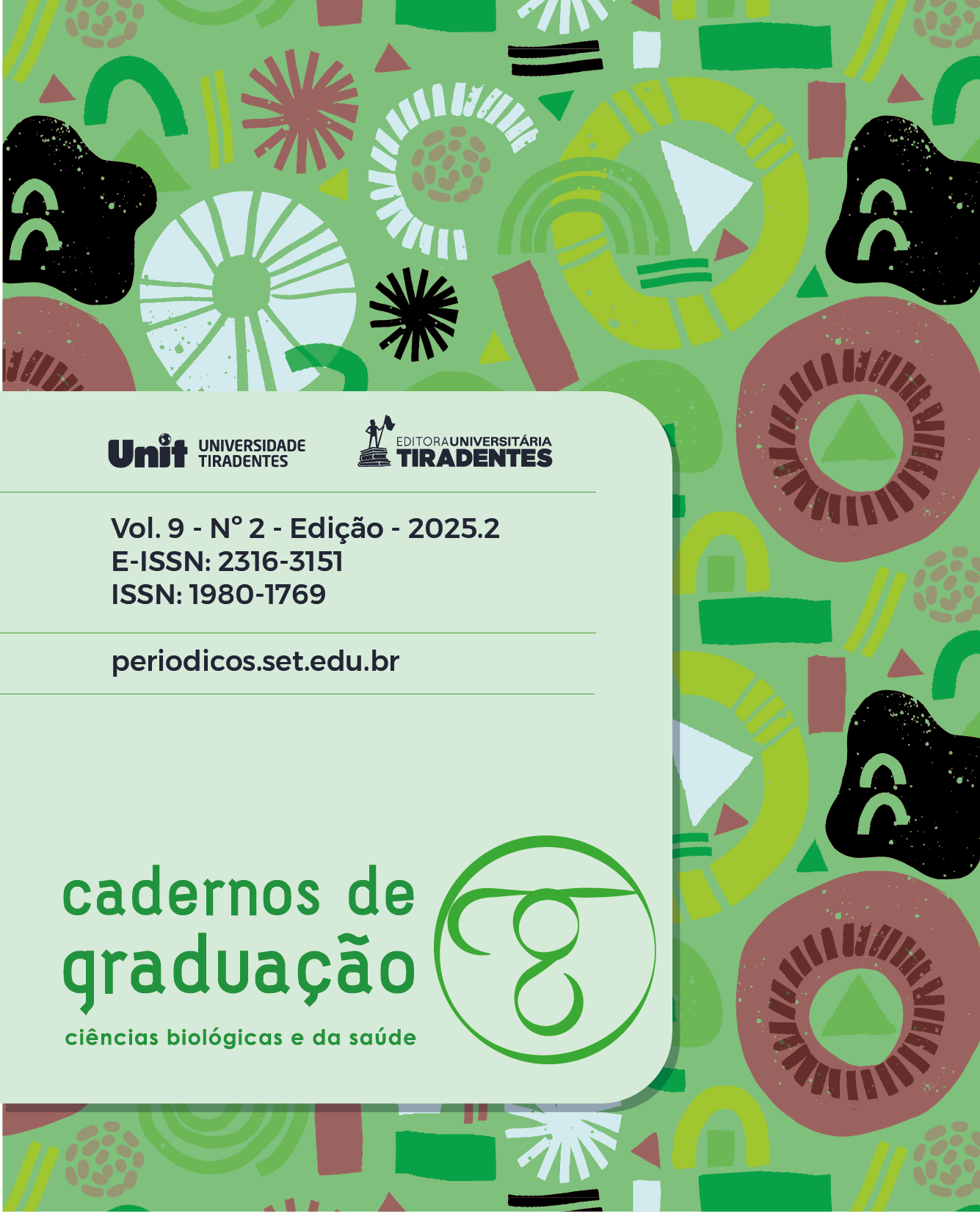THE ASSOCIATION BETWEEN URINARY TRACT INFECTIONS AND TYPE 2 DIABETES: AN INTEGRATIVE REVIEW
DOI:
https://doi.org/10.17564/2316-3151.2025v9n2p119-129Keywords:
Urinary Tract Infections, Type 2; DiabetesPublished
Downloads
Downloads
Issue
Section
License
Copyright (c) 2025 Caderno de Graduação - Ciências Biológicas e da Saúde - UNIT - SERGIPE

This work is licensed under a Creative Commons Attribution-NonCommercial-NoDerivatives 4.0 International License.
Oferece acesso livre e imediato ao seu conteúdo, seguindo o princípio de que disponibilizar gratuitamente o conhecimento científico contribui para a democratização do saber. Assume-se que, ao submeter os originais os autores cedem os direitos de publicação para a revista. O autor(a) reconhece esta como detentor(a) do direito autoral e ele autoriza seu livre uso pelos leitores, podendo ser, além de lido, baixado, copiado, distribuído e impresso, desde quando citada a fonte.
Abstract
Introduction: Type 2 diabetes mellitus (T2DM) is a chronic metabolic disorder characterized by persistent hyperglycemia, often associated with various systemic complications, including an increased susceptibility to infections. Among these, urinary tract infections (UTIs) stand out as prevalent comorbidities with significant impact on both the individual health of diabetic patients and public healthcare costs. Objective: To investigate the current state of the art regarding the relationship between type 2 diabetes mellitus and the occurrence of urinary tract infections. Methodology: To answer a guiding question “Do diabetic patients have a higher frequency or severity of urinary tract infections compared to non-diabetic patients?” an integrative review was conducted. The survey of articles was conducted in the PubMed, Virtual Health Library (VHL) and Cochrane Library databases. Results: Six international studies were included. The findings cover the prevalence and risk factors for these infections in individuals with T2DM, including aspects such as gender differences, etiological agents involved and hospitalization rates. Conclusion: The results demonstrate that individuals with T2DM, especially women and the elderly, have a higher incidence of urinary tract infections compared to non-diabetics, in addition to a higher risk of asymptomatic forms of these infections. Therefore, the importance of preventive measures, such as monitoring renal function, screening for asymptomatic bacteriuria and strict blood glucose control, is highlighted, with the aim of reducing complications and morbidity and mortality associated with UTIs in diabetic patients. It is also worth highlighting the need for further studies to deepen knowledge and guide more effective public health policies.
Keywords: Urinary Tract Infections; Diabetes Mellitus, Type 2; Infectious Complications.
How to Cite
References
BODKE, Harsh; WAGH, Vasant; KAKAR, Gauri. Diabetes mellitus and prevalence of other comorbid conditions: A systematic review. Cureus, v. 15, n. 11, p. e49374, 2023. Disponível em: https://pubmed.ncbi.nlm.nih.gov/38146555/. Acesso em: 27 mai. 2025.
DAI, M.; HUA S.; YANG, J.; GENG, D.; LI, W.; HU, S.; CHEN, H.; LIAO, X. Incidence and risk factors of asymptomatic bacteriuria in patients with type 2 diabetes mellitus: a meta-analysis. Endocrine, v. 82, n. 2, p. 263–281, 2023. Disponível em: https://pmc.ncbi.nlm.nih.gov/articles/PMC10543815/. Acesso em: 27 mai. 2025.
FELEKE, Berhanu Elfu; SHAW, Jonathan E.; MAGLIANO, Dianna J. Trends in rates of hospitalisation for infection in people with diabetes and the general population. Diabetic Medicine, v. 41, n. 12, 2024. Disponível em: https://pubmed.ncbi.nlm.nih.gov/39116262/. Acesso em: 25 mai. 2025
GALICIA-GARCIA, Unai; BENITO-VICENTE, Asier; JEBARI, Shifa; LARREA-SEBAL, Asier; SIDDIQI, Haziz; URIBE, Kepa B.; OSTOLAZA, César M. Pathophysiology of type 2 diabetes mellitus. International Journal of Molecular Sciences, v. 21, n. 17, p. 6275, 2020. Disponível em: https://pubmed.ncbi.nlm.nih.gov/32872570/. Acesso em: 27 mai. 2025.
MATTHIOPOULOU, G.; IOANNOU P.; MATHIOUDAKI A.; PAPADAKIS J. A.; DARAKI, V. N.; PAPPAS A.; SOURIS S.; MARAKI. STATHOPOULOU, C.; KOFTERIDIS, D. P. Asymptomatic bacteriuria in patients with type 2 diabetes mellitus. Infectious Disease Reports, v. 15, n. 1, p. 43–54, 2023. Disponível em: https://pubmed.ncbi.nlm.nih.gov/36648859/. Acesso em: 27 mai. 2025.
PETERSMANN, A.; MÜLLER-WIELAND, D.; MÜLLER, U. A.; LANDGRAF, R.; NAUCK, M.; FRECKMANN, G.; HEINEMANN, L.; SCHLEICHER, E. Definition, classification and diagnosis of diabetes mellitus. Experimental and Clinical Endocrinology & Diabetes, v. 127, supl. 1, p. S1–S7, dez. 2019. Disponível em: https://pubmed.ncbi.nlm.nih.gov/31860923/. Acesso em: 25 mai. 2025.
SALARI, N.; KARAMI, M. M.; BOKAEE, S.; CHALESHGAR, M.; SHOHAIMI, S.; AKBARI, H.; MOHAMMADI, M. The prevalence of urinary tract infections in type 2 diabetic patients: a systematic review and meta-analysis. European Journal of Medical Research, v. 27, n. 1, p. 20, 2022. Disponível em: https://pubmed.ncbi.nlm.nih.gov/35123565/> Acesso em: 27 mai. 2025.
SORESCU, T.; COSNITA, A.; BRAHA, A.; TIMAR, R.; TIMAR, B.; LICKER, M.; LAZAR, S.; GAITA, L.; ALBAI, O.; POPESCU, S. Predictive factors for urinary tract infections in patients with type 2 diabetes. Journal of Clinical Medicine, v. 13, n. 24, p. 7628, 2024. Disponível em: https://pubmed.ncbi.nlm.nih.gov/39768552/. Acesso em: 27 mai. 2025.
SOUZA, M. T. de; SILVA, M. D. da; CARVALHO, R. de. Integrative review: what is it? How to do it? Einstein (São Paulo), São Paulo, v. 8, n. 1, p. 102–106, 2010. Disponível em: https://www.scielo.br/j/eins/a/ZQTBkVJZqcWrTT34cXLjtBx/?lang=en. Acesso em: 27 mai. 2025.















